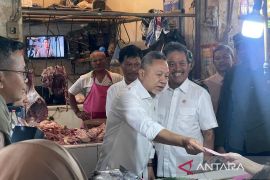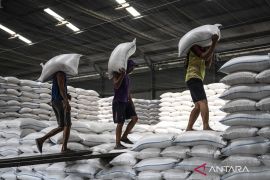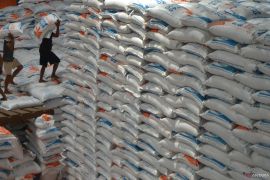Rice aid is one of the government's efforts to secure the rice price at the consumer level and maintain the inflation rate executed in three stages for three months to 21.3 million Benefit Recipient Families (KPMs), the ministry's official, Musdhalifah Machmud, stated.
The first stage of distribution commenced since March 2023, and each KPM will receive 10 kilograms of rice thrice, she noted during the inauguration of the National Simultaneous Cheap Food Movement here on Monday.
Machmud explained that food commodities contribute to the inflation rate, so their availability and price should be controlled.
In May, it was recorded that red onion, chicken, and rice each contributed 0.03 percent. Meanwhile, fresh fish, eggs, broiler chicken, garlic, and cayenne pepper each contribute 0.02 percent, while tomatoes contributed 0.01 percent to the inflation rate.
Meanwhile, the commodity that contributes the most to the inflation rate is red chili pepper, at 0.04 percent.
"In May, the general monthly inflation reached 0.09 percent, primarily driven by the changing price components recorded to contribute 0.09 percent and experienced 0.49 percent (mtm) inflation or 3.28 percent annually," she remarked.
Related news: Rice price sees decline in several regions: BPS
Machmud underlined that in order to meet the people's demand for cheap foods, the government has to encourage domestic farmers to produce food efficiently and affordably.
Fulfillment of the demand for several domestic food commodities still relies on production from overseas, including the fulfillment of meat demand through import, with the percentage reaching 40 percent.
Moreover, 20 percent of the demand for sugar consumption is being met through overseas imports.
Sugar demand for the food and beverage industry is fully met through domestic production. Some 80 percent of the demand for garlic and milk has to be met through imports.
In addition to increasing domestic production, Machmud also expects comprehensive availability of food logistics, from upstream to downstream, so that various commodities from regions with surplus can be distributed to regions with deficit.
"Efficient logistic facilities are necessary, so that the prices in the food recipient regions can still be affordable to all elements of society," she explained.
Related news: Government probes cause behind rice price hike despite harvest period
Related news: President Jokowi distributes rice reserves as food assistance in 2023
Translator: Kuntum Khaira R, Fadhli Ruhman
Editor: Yuni Arisandy Sinaga
Copyright © ANTARA 2023












